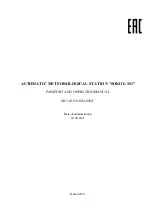
890464_k•en•2019-10-01
We reserve the right to carry out improvements
10
Cleaning
Photo sensors or solar panels must always be clean
to avoid incorrect measuring values and to ensure
operating reliability. The device should occasionally be
checked for soiling (e.g. bird droppings) and cleaned
carefully. Standard household cleaners may be used.
Do not use solvents.
In snowfall, check daily that the solar panel and pho-
todiodes are free of snow. A snow-covered weather
station may fail to function properly. If the energy in the
buffer is depleted, the weather station fails completely.
It resumes normal operation after it is recharged via
the solar panel.
The weather station may ice over and the wind wheel
may freeze up in extreme weather conditions. To avoid
wind damage, take your sun shading system out of
operation until wind monitoring can be resumed.
Never remove firmly attached layers of ice and snow.
Scratching, heat and chemical antifreeze agents may
damage the weather station.
Maintenance
There are no parts within the device that require mainte-
nance.
Strong vibrations at the installation location (for exam-
ple, from frequent high wind loads) can loosen the fixing
screws. If the joint screw is not properly tightened, the
orientation of the weather station may change as well.
Therefore, check from time to time that the weather
station is still firmly installed and that all screws are
sufficiently tight.
Liability
Failure to comply with the product information in these
instructions and use of the device in a manner that con-
travenes its intended use and purpose may result in the
manufacture refusing to honour warranty claims for prod-
uct damage. In this case, liability for consequential harm
to persons or damage to property will also be excluded.
Follow also the instructions in the operating manual of
your sun shading system. The automatic or manual opera-
tion of the sun shading system when iced over as well as
using the sun shading system during severe weather may
cause damages and must be prevented by the user by
taking suitable precautions.
ITNCE
R
The device meets the requirements on interfer-
ence resistance and interference emission for
use in residential and commercial areas.
Disposal
After its use, the device must be disposed off according to
legal regulations or returned to your local recycling centre!






























